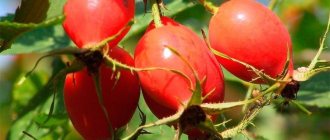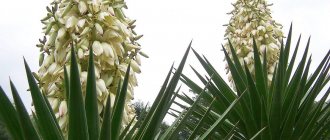Home page Wildlife World of plants
61 020 3.7 0
During the reign of Ivan the Terrible, the fruits, roots, and leaves of rose hips were considered one of the most useful medicines. The collection of berries was carefully monitored, and so that nothing would happen to them, they were stored in the Kremlin. Medicines made from them, including rosehip oil, were extremely expensive, and they were often exchanged for jewelry and furs.
Description of the plant Rosehip
Rosehip (Rōsa) is a shrub (subshrub) belonging to the Rosaceae family. It has about 500 species, and an even greater variety of varieties, according to some sources reaching fifty thousand. The traditional rose in our understanding is one of the cultivated species of this shrub. The plant dates back to ancient times and has a large number of different names that are used by gardeners. For example, it is often called “wild rose”, “shupshina”, “thorn color”. Why the rose hip plant was called this is explained quite simply - the bush has protective thorns located along the entire length of the branches. According to some historical versions, the name of the plant comes from the word “thorn” (thorn or point).
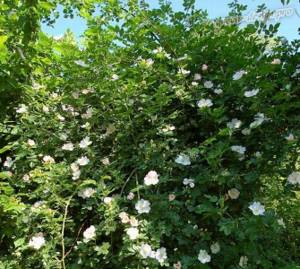
Most species are deciduous shrubs, but evergreens are also found. The most common species in gardening are represented by shrubs reaching three meters in height and having a well-branched crown. Less common are dwarf varieties, the maximum height of which reaches 25 cm. The plant is a long-livers, living up to fifty years or more.
"Wild Rose" has a taproot system, the main root of which can go deep into the ground up to five meters. The branches are erect, arched, abundantly covered with thorns. On young branches the thorns are soft, on adult branches they are hard and very sharp. The bark of the shoots is dark brown, dark red. The foliage on the branches is arranged spirally and has a reddish, bluish or greenish color. The leaf blades are hard, leathery and have a round or elliptical shape. The edge of the leaf is uneven, covered with a large number of serrations (serrate, double-serrate).
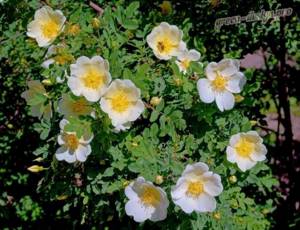
The perennial rosehip plant blooms with bright flowers, the diameter of which can reach 10 cm. The flowers can be single or collected in shield-shaped, paniculate inflorescences. The petals come in different shades: snow-white, yellow, cream, red or pink. During flowering, the garden is filled with a delicate, pleasant aroma. The flowering period begins in late spring, early summer and lasts about three weeks.
At the age of three, the bush begins to bear fruit. Rose hips are visually similar to small (1-1.5 cm long), round nuts of red, orange, sometimes purple or black. It contains a large number of seeds inside. The pulp is fibrous and has a tart-sweet taste. The fruit ripens in early autumn.
Collection and storage
Fruit harvest usually occurs in early to mid-August, depending on the climate in the area and the weather in a particular year. If drying and long-term storage are planned, then it is enough to wait until the berries turn red and start picking immediately after that. In cases where the harvester plans to use the fruits as a raw material for making jam, marshmallows or marmalade, it makes sense to wait about another week or two. Then the overripe pulp will become more tender and pliable. It is much easier to clean it of impurities - seeds and sepals.
But still, drying is most often used as the simplest method, which ensures a significant shelf life of the product and does not destroy valuable microelements and vitamins.
You can use a regular vegetable dehydrator, which are sold in many stores.

Regular drying on a hot day would also be a good choice. The collected berries (along with the sepals) are poured onto metal corrugated trays and placed in a warm, dry, but shaded place. The iron tray heats up quickly and then the berries actively dry. But it still takes up to a week to completely dry, depending on the temperature and humidity.
You should not place pallets in the sun. On the one hand, this speeds up the drying process. But on the other hand, efficiency decreases sharply. Due to strong heating, the top layer dries out completely and can no longer allow moisture to pass through. But inside, in the seeds, it will remain. And it will be almost impossible to get rid of it - you will have to break the berries so that the moisture can easily escape during further drying.
It is very important to dry the berries well - even a small amount of moisture can lead to the development of fungus and mold, making the fruit completely unsuitable for consumption. To check this, just mash several berries from different parts of the tray between your fingers. If the particles scatter, it means the drying was successful. If the pulp or seeds become even a little smeared, it is necessary to continue drying to prevent spoilage.
If you plan to dry a small amount of fruit, you can use the oven. It is heated to a temperature of about 70-80 degrees Celsius, after which baking sheets with berries are placed there. Then the door closes, leaving only a small gap for ventilation and removal of excess moisture. Drying lasts about two days - plus or minus 12 hours. This depends on the initial moisture content of the fruit and its size. After this period, it is necessary to check the readiness of the berries using the method described above. If they are not dry, you should return the baking sheet back to the oven.
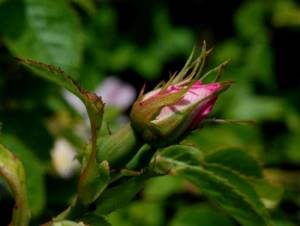
After this, the dried berries are poured into canvas bags and put away for storage - in a dry, preferably cold, dark and well-ventilated place. In this form, they can easily be stored for several years without losing their beneficial properties, for which they are highly valued by experts.
Rosehip plant: planting and care
The shrub is unpretentious in care. It is preferable to plant in the garden in mid-autumn in well-lit areas of the garden. Considering that the root system is quite developed and very deep, it is not recommended to place it in lowlands where moisture can accumulate, in areas with nearby groundwater. Excessive moisture leads to rotting of the rhizome. The soil is preferably fertile, neutral acidity. The soil should be loose and well drained.
Young seedlings need regular watering, but you should avoid waterlogging the soil. Mature bushes can do without watering, being content with natural precipitation. In the hot, dry season, water should be watered as the soil dries out.
For intensive growth and good fruiting, the plant needs regular feeding. They begin to fertilize the next year after planting, adding nitrogen fertilizers to the soil in spring, autumn and summer. In early spring and late autumn (in preparation for winter), fertilizing with organic fertilizers (humus) is also carried out.
Proper care involves regular pruning. It is carried out both for crown formation and for sanitary and health purposes. In early spring, before the buds swell, damaged shoots are pruned, thinned out and a crown is formed. Young branches are pruned, those that have reached the age of seven are completely cut out, giving the shrub the opportunity to renew itself.
Resistance to environmental conditions and diseases
In general, the described plant is considered to be quite resistant to high levels of humidity, diseases and pests, not to mention the frost resistance of adult bushes. However, in order to achieve the most positive result of cultivation, you should not neglect spring preventive treatments.

Typically, solutions of Bordeaux mixture, copper sulfate or weak solutions of complex insecticidal or fungicidal preparations are used for these purposes. The use of the latter will be relevant if cases of mass damage to the root and above-ground parts of cultivated crops by rot and other ailments have already been noticed in the garden.
We recommend learning how to replant rose hips in the spring.
By putting a little effort into planting and further caring for the vitamin variety VNIVI, you will provide yourself with a lot of useful fruits that are perfect for use for medicinal purposes.
Culture propagation
Rosehip is an angiosperm plant that can be propagated by seed or vegetative methods. Let's take a closer look at each of them.
Growing Rosehip from seeds at home
For propagation, seeds are collected in August from unripe fruits. You can sow seeds in open ground in October. To do this, add a small amount of humus mixed with sawdust into the prepared grooves. Sow the seeds at a distance of 5 cm from each other. The first shoots appear next spring. To speed up germination, in the spring the planting can be covered with plastic film, thus creating a protective cap. When using film, it must be removed regularly for ventilation and watering. After the emergence of seedlings, the film is removed, and when the seedlings have several strong leaves, they are planted.
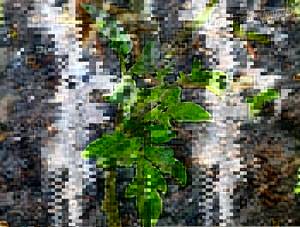
You can sow seeds in spring. In this case, they need preliminary stratification. The seeds are first mixed with sand and peat and placed in the refrigerator for a while.
The seed method of propagation does not fully guarantee the preservation of all characteristics of the mother culture. To fully preserve them, it is advisable to use propagation by cuttings and offshoots.
Growing Rosehip from cuttings
Cuttings are often harvested in spring, summer, and less often in autumn. For cuttings, young, non-lignified shoots with buds are selected. Cuttings from young, healthy shoots take root quickly. The cuttings should have 2-4 viable buds. A sharp, horizontal cut is made above the upper bud, and an oblique cut is made from below the shoot.

Half of the foliage from the shoot must be removed, leaving only those at the top. The bottom of the cutting is treated with a special agent for intensive root growth and buried in the prepared soil. It is advisable to protect the planting with a cap, creating greenhouse conditions. Regularly airing and watering the seedling will quickly take root.
Reproduction of shrubs by offsets
Side branches may appear from the root of a perennial shrub, which are suitable for creating a branch. If the shoot is large enough (height from 25 cm), it can be carefully cut out with a sharp shovel and transplanted to a separate place. It is better not to immediately separate small branches from an adult bush. They are first bent a little to the side and sprinkled with soil. Periodically, the soil is added and compacted. When the offspring separates from the adult plant, it can be dug up and replanted separately. It is better to do tappings in the spring; the young seedling will have the opportunity to prepare for winter.
Interesting facts about rose hips
- Rosehip was so valued in the Renaissance, and then in modern times, that valuable things were exchanged for it - fur, velvet, satin. In those years, these fruits were widely used as a remedy against scurvy. Still would! After all, rose hips contain 10 times more vitamin C than blackcurrants and 50 times more than lemons! Moreover, all types of plants contain different amounts of this substance. Thus, Begger's rosehip is recognized as the absolute record holder, in which vitamin C can contain from 7 to 20%.
- The oldest representative of this plant grows in Germany. True, his age cannot be accurately determined. Some scientists believe that the old bush is 400 years old, while others proclaim that it is 1000.
- If you arrived at the dacha, but did not take your watch with you, you can find out the time by looking at the rosehip flowers. They “wake up” at 4-5 in the morning, and “go to bed,” that is, they close at about 19-20 hours.
- In Ancient Greece, there was a tradition of strewing the path of the newlyweds with rosehip flower petals, as they symbolized love and passion.
- The Slavs attached approximately the same importance to the fruits of this plant, and therefore they were used in wedding ceremonies and for preparing “love” dishes.
Do you prepare such rosehip potions for your “halves”? How do you even eat these healthy berries?
Types and varieties of Rosehip
Among the species and varietal diversity, when selecting for a garden plot, it is worth paying attention to such crops.
Rose hip plant (Rosa majalis)
the most popular species, widespread in Europe. Its height reaches three meters, the branches form large thorny thickets that require regular thinning.
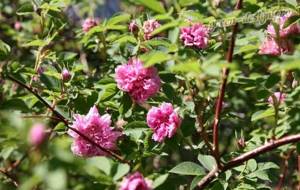
The flowers are large, the petals are pale and bright pink, there are varieties with double flowers. The branches are abundantly covered with thorns. Frost-resistant species.
Dahurian rose hip (Rosa davurica)
Grows up to 1.5 height. The leaves are imparipinnate, up to 8 cm long, with slight pubescence below. The bark is brown, purple-black.
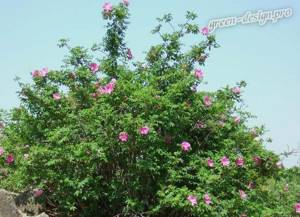
It blooms in early summer with small dark pink flowers. It is distinguished by a small number of thorns, located in pairs at the base of branches and leaves. The fruits are red;
Rosehip (Rosa rugosa)
Oriental, very decorative representative of the genus. They mistakenly think that wrinkled rosehip is a herbaceous plant.

Its height reaches 2.5 meters, and its branches are spreading. It got its name because of the leaves, which are visually strongly wrinkled and have gray-green pubescence. Large flowers (up to 12 cm in diameter) with pink and white petals, collected in fragrant inflorescences. The bush blooms all summer, because of this, on its crown you can simultaneously observe loose and withered buds and ripe berries.
Care
In the first years of life, care consists of watering and weeding. From the third year, it is advisable to apply mineral fertilizers: ammonium nitrate (20–30 g per 1 m2 of soil). When starting to bear fruit, 20 g of potassium salt and 50 g of superphosphate are added per bush every two to three years. It is better to give fertilizers before watering, scattering them evenly over the entire crown projection and incorporating them into the soil with shallow loosening (12–15 cm). This agricultural technique contributes to a significant increase in yield.
Rosehip care also includes pruning. Bushes are pruned from the first year of life, expanding them at the base of the bush. In the future, pruning of diseased and dry branches is carried out. To speed up fruiting, young shoots are pinched.
Fruiting begins in the second year, the commercial harvest is harvested in the fourth year (from 2.5 to 5 kg per bush). The most productive varieties include Yubileiny, Globus, Rubin, Titan, Svetofor, and Rossiysky.
On a personal plot, the rosehip crop is harvested by hand. The first sign of fruit ripening is a dark orange or red color and juicy pulp.
Currently, the largest-fruited varieties include Yubileiny, Yablochny, Titan, Dar Leta, Oval, and Globus. When assessing the taste of fruits with a high score, the following varieties can be distinguished: Vitamin, Globus, Captain, Rumyany, Ural Champion, Yubileiny.
| Rosehip Jubilee | Rosehip Pobeda |
Medicinal properties of the rose hip plant
The medicinal plant rose hips is a storehouse of useful substances. It is used in folk medicine, pharmacology, and cosmetology as an additive to various medicines and cosmetics.
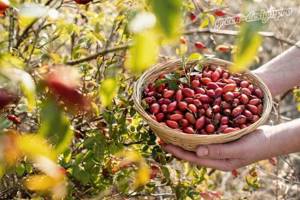
All components of the crop are used in medicine: fruits, petals, branches, leaves and roots. The fruits of the bush are rich in antioxidants and vitamins. Used for the production of vitamin complexes used for exhaustion and anemia. Also, the components of the culture are used in medicines intended to treat diseases of the gastrointestinal tract and genitourinary system. Infusions and extracts are used in cosmetology in the treatment of acne and other skin diseases.
You can talk a lot about the benefits of this bush, but you should also warn about caution. Decoctions and infusions with its components should be limited to people with high blood pressure. Long-term use of medications based on this shrub is not recommended for people with liver problems; its components can inhibit the process of bile excretion. People with heart problems should also be careful. Like any medicinal plant, rosehip can be useful, but if used incorrectly it can cause harm, exacerbating chronic ailments. When taking medications, you should definitely consult a specialist.
Use of rose hips in cooking

Have you ever tried rosehip jam?
Since the fruits of this plant are record holders for vitamin C content, it is quite natural that they will bring the greatest benefit to our body in their original form.
Those who brew rosehip tea lose most of the nutrients, but they gain an unusual, tasty drink, to which honey can be added when warm. In addition, from these berries you can cook compotes and jelly, squeeze juice, prepare fruit drinks and kvass.
If you want to preserve maximum vitamin C in the fruits, make yourself a healing infusion: place them in a thermos, fill with warm water (+40 °C) and leave overnight. During this time, the water will absorb all the valuable properties of the fruit and become healing itself! Also, jam, marmalade, and jam are made from rose hips. You can try making marshmallows, marmalade, and candied fruits.
Infrequently, but not so rarely, ripe rosehip berries are added to baked goods - pies, muffins, pies, cookies. They decorate confectionery products - cakes and pastries.
Based on these fruits, you can prepare spicy, hot, sweet and sour sauces for pancakes, pancakes, flatbreads and savory dishes. Try combining them with spices: curry, cinnamon, cloves, vanilla, cardamom, as well as ginger, red onion, garlic, chili pepper.
The Swedes make an unusual soup from rose hips called “Nyponsoppa”, which also contains water, potato starch and sugar. Dried berries are soaked in water, boiled until soft, crushed in a blender and rubbed through a sieve to remove the prickly seeds.
The starch is diluted first in cold water, and then gradually poured into the hot water while stirring; sugar and rosehip puree are added to the same, but in boiling water. “Nyponsoppa” poured into plates is decorated with cream and almond chips. Maybe in Sweden this dish is called soup, but in Russia it would most likely be considered jelly.

